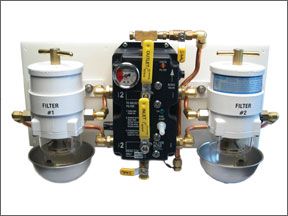For people concerned about losing fuel flow to their sailboat auxilliary engine while underway due to a clogged fuel filter, the FilterBOSS looks like a promising solution. The FilterBOSS can be ordered as a stand-alone unit ready to be plumbed into your existing fuel system ($950), or as part of a pre-mounted system containing your choice of two Racor filters (various models available). The unit we received for review was the 500FG Dual Filter Package, which includes a FilterBOSS with wiring harness and two Racor 500FG filters mounted and connected with rigid tubing on a pre-drilled, composite panel ($1,565). It features Type 1 copper tubing (.035-inch wall thickness), Bi-Lok CA360 grade brass fittings, heavy-duty valves (with Viton seals), and a Con-X weather-tight cannon plug for the wiring harness. The system also allows a convenient way to polish your fuel and rid it of debris that may clog your fuel system.
***

288
While theres no good time for a clogged fuel filter, it always seems to happen at the worst possible moment, like when youre running a rough inlet and wave action stirs up long-dormant crud from the bottom of your tank. For situations like these, a dual-filter installation can give you some extra running time, possibly making the difference between getting through that inlet or not.
Most vessels come equipped with an external primary fuel filter (mounted between the fuel tank and engine) to strain out the bulk of gunk and goo your fuel system accumulates (solids, water, micro-organisms, etc.) prior to reaching the finer filter on the engine. Technically, this means you already have dual filters, but in reality-with both filters in series-once the primary clogs, youll have to shut down the engine to change it-a particularly grueling task in poor conditions.
You can convert to a dual fuel filter system by adding a second primary filter to your existing system or by installing a pre-engineered system, such as the FilterBOSS by KTI Systems. Designed for use with diesel engines with a maximum flow rate of 35 gallons per hour, the FilterBOSS is a modular unit containing a fuel pump, an integral, vacuum-based fuel-flow monitoring system, and a manifold designed to allow two filters to be installed (one online and one offline on standby). The vacuum gauge allows users to monitor the online filters condition and indicates when its necessary to switch to the second filter (the higher the readings, the dirtier the filter). An internal vacuum switch also allows for a remote warning indicator-say, mounted at the helm-for easier visibility outside the engine compartment.
Once switched to the second filter, the FilterBOSS pump makes short work of servicing the filter and bleeding the engine, should the need arise. It can also help get you back to the dock by providing fuel to your engine in the event of a fuel-pump failure.
The FilterBOSS also offers the option of plumbing the system to enable fuel polishing, either at the dock (during and after fueling) or while under sail, when tank crud is most likely to be stirred up. If polishing underway, the manufacturer recommends you begin polishing after the sails are hoisted and the engine is off. Because no vacuum is created during polishing, starting the engine is the only way to check filter status. So before proceeding under power with your newly polished fuel, start the engine and check the vacuum gauge to see whether the filter was clogged during the polishing. Another potential problem would be forgetting to turn off the FilterBOSS fuel pump, which would also affect vacuum gauge readings. Its important to note that if one filter clogs in heavy weather, the second may do the same soon (depending on the level of gunk in your tank). After switching to your No. 2 primary, swap out the clogged No. 1 filter as soon as possible, so itll be ready should the other one clog.
The FilterBOSS can be ordered as a stand-alone unit ready to be plumbed into your existing fuel system ($950), or as part of a pre-mounted system containing your choice of two Racor filters (various models available). The unit we received for review was the 500FG Dual Filter Package, which includes a FilterBOSS with wiring harness and two Racor 500FG filters mounted and connected with rigid tubing on a pre-drilled, composite panel ($1,565). It features Type 1 copper tubing (.035-inch wall thickness), Bi-Lok CA360 grade brass fittings, heavy-duty valves (with Viton seals), and a Con-X weather-tight cannon plug for the wiring harness.
The unit we tested does not come with the heat shields recommended by American Boat and Yacht Council safety standards for fuel filters mounted in an enclosed engine space. According to ABYC standards, such filters should have metal heat shields to protect the fuel filters plastic bowls from melting in high temperatures. Another FilterBOSS model, the DFP500MA, comes standard with heat-shielded Racors. At $1,650, its a little more expensive, but if youre mounting it near an engine, this would be the model to choose.
FilterBoss makers couldnt estimate a units lifespan, but they did tell us that replacing the units pump after the warranty expires would cost less than $200, if its returned to KTI Systems for repair.
We plan to install the FilterBOSS on our test boat and put it through its paces. Well keep you posted.

































